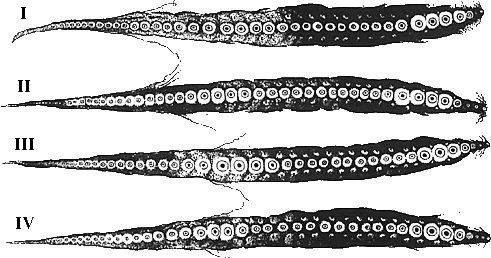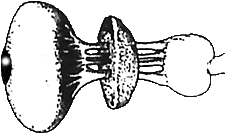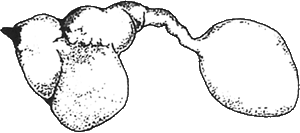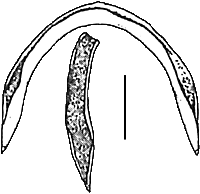- Arms
Drawings below are enlargements of the arms of the holotype. The pertinent arm characters are repeated here from the branch page.- Arms subequal.
- Arms I with slight increase in thickness.
- Web nodules or web supports absent.
- Arms subequal; arm sucker count 60-67.
- Arms I with slight increase in thickness.
- Web nodules or web supports absent.
- web more extensive on dorsal arms; Web formula - A=B>C=D>E.
- Males with two fields of enlarged suckers present on all arms; largest sucker diameter of distal field approximately equal to that of proximal field.
- Proximal field with suckers 4-9 typically enlarged; suckers 6 or 7 usually largest; all arms with equal enlargement.
- Distal field with usually 9-14 suckers enlarged beginning with sucker numbers 18-19; suckers 22-24 usually largest; all arms with equal enlargement.
- The drawing on the left shows the relative size and arrangement of suckers and cirri.
 Click on an image to view larger version & data in a new window
Click on an image to view larger version & data in a new window
Figure. Oral view of arms of O. hardyi, holotype, showing sucker arrangement. Drawings from Villanueva et al., 2002.
 Click on an image to view larger version & data in a new window
Click on an image to view larger version & data in a new window
Figure. Arrangement of suckers and cirri from segment of one arm of O. hardyi. Drawing from Villanueva et al., 2002.
- Eyes
- Not described.
- Funnel
- Funnel organ not discernible.
- Fins
- Without lobe near anterior insertion in preserved specimens.
- Fins contracted on preservation; appear short.
- Gills
- Small, half-orange appearance.
- 7 primary lamellae per gill.
- Optic lobes and nerves
- Optic lobes kidney-shaped.
- 4 optic nerve tracts pass through/by white body.
- Digestive tract
- Intestine approximately same length as esophagus.
- Digestive gland unilobular.
- Male reproductive system
- Accessory gland "2" largest.
- Penis short.
- Female reproductive system
- Not known.
- Not known.
- Shell
- U-shaped with short, flaring lateral wings.
- Outer surface of saddle concave due to highly inrolled edges; inner surface convex. Saddle with U-shaped cross-section.
- Lateral wings with inrolled margins, tapers to acute points.
- Pigmentation
- Skin orange-brown in the fresh octopod, reddish-brown after preservation.
- Oral surface of web deeply pigmented centrally; oral surface of arms much less pigmented.
- Areolae not apparent.
- Measurements
Comments
The above description is taken from Villanueva et al., 2002. The digestive system was not completely dissected. Therefore, information on the beaks, radula, salivary glands and shape of the intestine is not known. The extreme inrolling of the margins of the shell could be due to freezing prior to fixation (Villanuevaet al., 2002).






 Go to quick links
Go to quick search
Go to navigation for this section of the ToL site
Go to detailed links for the ToL site
Go to quick links
Go to quick search
Go to navigation for this section of the ToL site
Go to detailed links for the ToL site